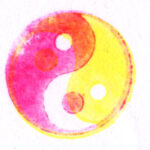What is Shiatsu?
Shiatsu is a Japanese form of bodywork. Literally translated, shiatsu means finger pressure.
Gentle to powerful sinking with fingers and hands, stretching of the muscles and mobilization of the joints are central techniques in shiatsu. As in acupuncture, meridians (energy pathways) and acupoints are stimulated to harmonize the energy flow of body and mind.
Treatment is given on the clothed body, traditionally on a mat on the floor, or alternatively on a massage table or chair. The person receiving the massage can be covered and supported with pillows and cushions.

Background
Zen Shiatsu, which I practice, is one of several directions that have developed since the origins of Shiatsu about 100 years ago. It combines traditional Japanese massage techniques with approaches of traditional Chinese medicine (TCM).
In Zen Shiatsu it is assumed that everything in nature is connected and interacts with each other and that all living things are subject to constant change.
The model of the five phases of change, to which the meridians are also assigned, describes this change as a constant cycle of different energetic qualities. Examples are the change of the seasons, the different phases of life we go through from birth to death or the flow of our different emotions. Depending on what your needs are, I can strengthen or balance these different qualities by treating the meridians, for example to come to rest or to move, to let go, to find stability or to set boundaries.
Shiatsu is practiced with an attitude of mindfulness, which also underlies Zen Buddhism. Mindfulness is based on the principles of non-judgment, patience, keeping the beginner's mind, trust, non-forcing, acceptance, and letting go.

How does Shiatsu work?
Shiatsu works in a needs-oriented way. Symptoms are seen as signposts that draw attention to deeper needs. In a Shiatsu treatment these needs are perceived, accepted and answered on the level of bodywork.
Shiatsu leads to deep relaxation. By shifting weight and moving from the center of the body, the intensity of the treatment is sensitively adapted to the respective need. The attentive posture and physical centeredness with which Shiatsu is practiced create a space in which you can experience security, connection and a respectful approach to boundaries. A feeling of being carried and deep relaxation can set in.
Shiatsu regulates the nervous system. A healthy balanced nervous system oscillates in waves between activation (fight and flight / freeze mode) and relaxation (healing / restoritive mode). Through continuous stress or trauma, the nervous system is constantly in increased activation. Regenerative processes such as sleep, digestion and metabolism can only take place sufficiently if the nervous system regularly returns to a state of rest. Due to its deep relaxing effect, Shiatsu supports all stress-related symptoms such as tension, pain and digestive problems. It supports trauma healing, grounds in times of major change and activates the self-healing powers.
Shiatsu strengthens body awareness. Our body stores all the important experiences we have in the course of our lives. From this memory it draws knowledge about what is good for us and what is bad for us. Shiatsu helps us to connect with this body wisdom and to consciously experience it. Regular treatments can deepen your relationship with your own body so that it becomes a natural part of your everyday experience.
Shiatsu connects. Touch and connection are basic human needs and the prerequisite for healing and development. Mindful touch creates a feeling of security. You can feel connections between different areas of the body and perceive your body, mind and emotions as one.
